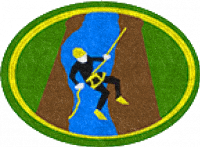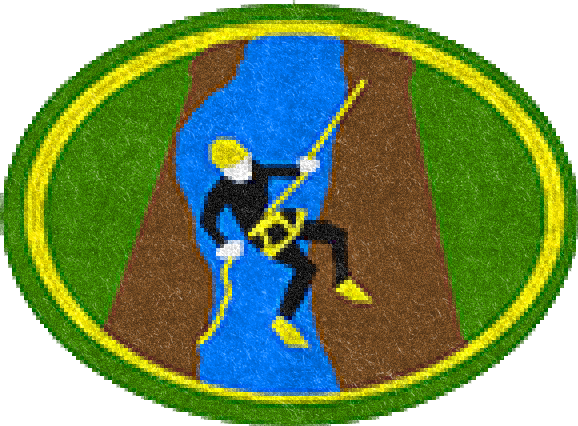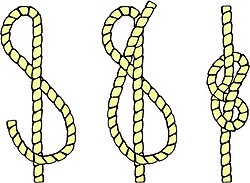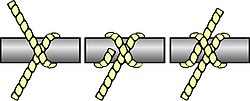|
|
| Line 16: |
Line 16: |
| | <!-- 2. ¿Cómo se forman los cañones? --> | | <!-- 2. ¿Cómo se forman los cañones? --> |
| | | | |
| − | <div lang="en" dir="ltr" class="mw-content-ltr">
| + | {{clear}} |
| − | Rivers that lie at the bottom of deep canyons are known as entrenched rivers. They are entrenched because, unlike rivers in wide, flat flood plains, they do not meander and change their course.
| |
| − | </div>
| |
| | | | |
| − | <div lang="en" dir="ltr" class="mw-content-ltr">
| + | {{clear}} |
| − | Weathering and erosion also contribute to the formation of canyons. In winter, water seeps into cracks in the rock. This water freezes. As water freezes, it expands and turns into ice. Ice forces the cracks to become larger and larger, eroding bits of stone in the process. During brief, heavy rains, water rushes down the cracks, eroding even more rocks and stone. As more rocks crumble and fall, the canyon grows wider at the top than at the bottom.
| |
| − | </div>
| |
| | | | |
| − | <div lang="en" dir="ltr" class="mw-content-ltr">
| + | {{clear}} |
| − | When this process happens in soft rock, such as sandstone, it can lead to the development of slot canyons. Slot canyons are very narrow and deep. Sometimes, a slot canyon can be less than a metre (3 feet) wide, but hundreds of metres deep. Slot canyons can be dangerous. Their sides are usually very smooth and difficult to climb.
| |
| − | </div>
| |
| | | | |
| − | <div lang="en" dir="ltr" class="mw-content-ltr">
| + | {{clear}} |
| − | Some canyons with hard, underlying rock may develop cliffs and ledges after their softer, surface rock erodes. These ledges look like giant steps.
| |
| − | </div>
| |
| | | | |
| − | <div lang="en" dir="ltr" class="mw-content-ltr">
| + | {{clear}} |
| − | Canyons are also formed by tectonic activity. As tectonic plates beneath the earth’s crust shift and collide, their movement can change the area’s landscape. Sometimes, tectonic activity causes an area of the earth’s crust to rise higher than the surrounding land. This process is called tectonic uplift. Tectonic uplift can create plateaus and mountains. Rivers and glaciers that cut through these elevated areas of land create deep canyons. The Grand Canyon, in the U.S. state of Arizona, is a product of tectonic uplift.
| |
| − | </div>
| |
| | | | |
| | <noinclude></noinclude> | | <noinclude></noinclude> |
| Line 52: |
Line 42: |
| | {{honor_prerequisite|honor=Abseiling|displayname=Rápel}} | | {{honor_prerequisite|honor=Abseiling|displayname=Rápel}} |
| | | | |
| − | <div lang="en" dir="ltr" class="mw-content-ltr">
| + | {{clear}} |
| − | Good technique means you abseil at a steady speed. The belay device moves gently and steadily, with your legs at roughly right angles to the rock face, knees slight bent, feet shoulder width apart. Descend gently by walking backwards using the friction of the rope through the belay device to control the speed.
| |
| − | </div>
| |
| | | | |
| − | <div lang="en" dir="ltr" class="mw-content-ltr">
| + | {{clear}} |
| − | PLAN AND CONTROL the points where the rope will touch the rock. Look for smooth areas and use your body so the rope lies on those areas. Avoid sharp edges. Once the rope is touching the rock, go straight down. No right, no left, no swinging, as this causes rubbing between rope and rock. When the rope is weighted, it’s very easy to cut it on sharp edges.
| |
| − | </div>
| |
| | | | |
| − | <div lang="en" dir="ltr" class="mw-content-ltr">
| + | {{clear}} |
| − | {| border="1" cellspacing="0" cellpadding="4" style="text-align: center" | |
| − | !style="background:#4d5f40; color:white;"|Call
| |
| − | !style="background:#4d5f40; color:white;"|Response
| |
| − | !style="background:#4d5f40; color:white;"|Call
| |
| − | !style="background:#4d5f40; color:white;"|Response
| |
| − | |-
| |
| − | |style="color:#4d5f40;"|''<b>"On Rope"</b>'' || Called to by the abseiler to advise the belayer that the abseiler is attached to the rope and has a positive brake. || style="color:#4d5f40;"|''<b>"On Belay"</b>'' || Called by the belayer to let the participant know they’re on the end of the rope with a positive brake.
| |
| − | |-
| |
| − | |style="color:#4d5f40;"|''<b>“Descend When Ready”</b>'' || Called by the belay to advise the abseiler that the belayer is aware the abseiler is descending and that the belayer is ready to arrest a fall if necessary. || style="color:#4d5f40;"|''<b>“Descending”</b>'' || Called by the abseiler when the abseiler is about to begin descent.
| |
| − | |-
| |
| − | |style="color:#4d5f40;"|''<b>“Safe”</b>'' || Called by abseiler to let the belayer know they are on the ground.
| |
| − | |-
| |
| − | |style="color:#4d5f40;"|''<b>“Off Rope”</b>'' || Called by abseiler when the abseiler has completed the descent and all the abseiler’s equipment has been removed from the rope. || style="color:#4d5f40;"|''<b>“Off Belay”</b>'' || Called by the belayer when they are no longer safeguarding the participant.
| |
| − | |-
| |
| − | |style="color:#4d5f40;"|''<b>“Rocks”</b>'' || Used when a object is dislodged or falls over the edge. It is to warn personnel below that they should seek shelter. || style="color:#4d5f40;"|''<b>“Up Rope”</b>'' || Called by abseiler when they want less slack in the belay.
| |
| − | |}
| |
| − | </div>
| |
| | | | |
| | <noinclude></noinclude> | | <noinclude></noinclude> |
| Line 86: |
Line 55: |
| | <!-- 5. Demostrar cómo cuidar adecuadamente las cuerdas y el equipo después de su uso en un cañón. --> | | <!-- 5. Demostrar cómo cuidar adecuadamente las cuerdas y el equipo después de su uso en un cañón. --> |
| | | | |
| − | <div lang="en" dir="ltr" class="mw-content-ltr">
| + | {{clear}} |
| − | <i>'''What causes damage?'''</i>
| |
| − | * Wear with normal use
| |
| − | * A fall (tearing or stretching of stitching and webbings)
| |
| − | * Prolonged exposure to UV radiation
| |
| − | * Contact with chemical products (acids, oil, fuel)
| |
| − | * Storage in damp or insufficiently ventilated areas
| |
| − | * Contact with heat sources (welding shards, gas burners, cigarette butts)
| |
| − | * Rough handling (scuffing along walls or against other material; an aluminium carabiner used on a steel lanyard wears very quickly)
| |
| − | * Use in dirty conditions. A rope that has been used in a grit environment, such as a canyon can develop micro abrasion of internal fibres weakening the rope. Dirty ropes also abrade other equipment faster.
| |
| − | </div>
| |
| | | | |
| − | <div lang="en" dir="ltr" class="mw-content-ltr">
| + | {{clear}} |
| − | <i>'''Washing Ropes and Soft Components:'''</i>
| |
| − | '''DON'T'''<br>
| |
| − | Use a pressure washer, degreaser, stain remover or solvent. Do not dry material in the sun or near a heat source such as a radiator or stove.
| |
| − | </div>
| |
| | | | |
| − | <div lang="en" dir="ltr" class="mw-content-ltr">
| + | {{clear}} |
| − | '''DO'''<br>
| |
| − | Rinse with cold water or wash with lukewarm water (max. 30 degrees) and PH neutral soap or rope/PPE cleaner. If necessary, use a small brush to remove dirt. Rinse material with clean water after washing. Hang to dry in a wellventilated area out of direct sunlight.
| |
| − | </div>
| |
| | | | |
| − | <div lang="en" dir="ltr" class="mw-content-ltr">
| + | {{clear}} |
| − | A dirty rope can damage other material, accelerate wear (greatly) and reduce the braking effect of devices. That’s why keeping your rope clean is important. For example, use a rope bag to prevent unnecessary soiling.
| |
| − | </div>
| |
| | | | |
| − | <div lang="en" dir="ltr" class="mw-content-ltr">
| + | {{clear}} |
| − | <i>'''Metal components:'''</i>
| |
| − | Rinse or wash with water at a maximum temperature of 30 degrees and a suitable PPE cleaner or PH neutral soap. Be careful with high pressure: you can blow away the necessary oil/lubrication. Oil moving components with a light weight oil such as sewing machine oil or use graphite for lubrication.
| |
| − | </div>
| |
| | | | |
| | <noinclude></noinclude> | | <noinclude></noinclude> |
| Line 138: |
Line 85: |
| | <!-- b. Figura de ocho --> | | <!-- b. Figura de ocho --> |
| | | | |
| − | <div lang="en" dir="ltr" class="mw-content-ltr">
| + | {{:AY Honors/Knot/Figure 8/es}} |
| − | {{:AY Honors/Knot/Figure 8}} | |
| − | </div>
| |
| | | | |
| | <noinclude></noinclude> | | <noinclude></noinclude> |
| Line 163: |
Line 108: |
| | <!-- e. Ballestrinque --> | | <!-- e. Ballestrinque --> |
| | | | |
| − | <div lang="en" dir="ltr" class="mw-content-ltr">
| + | {{:AY Honors/Knot/Clove hitch/es}} |
| − | {{:AY Honors/Knot/Clove hitch}} | |
| − | </div>
| |
| | | | |
| | <noinclude></noinclude> | | <noinclude></noinclude> |





